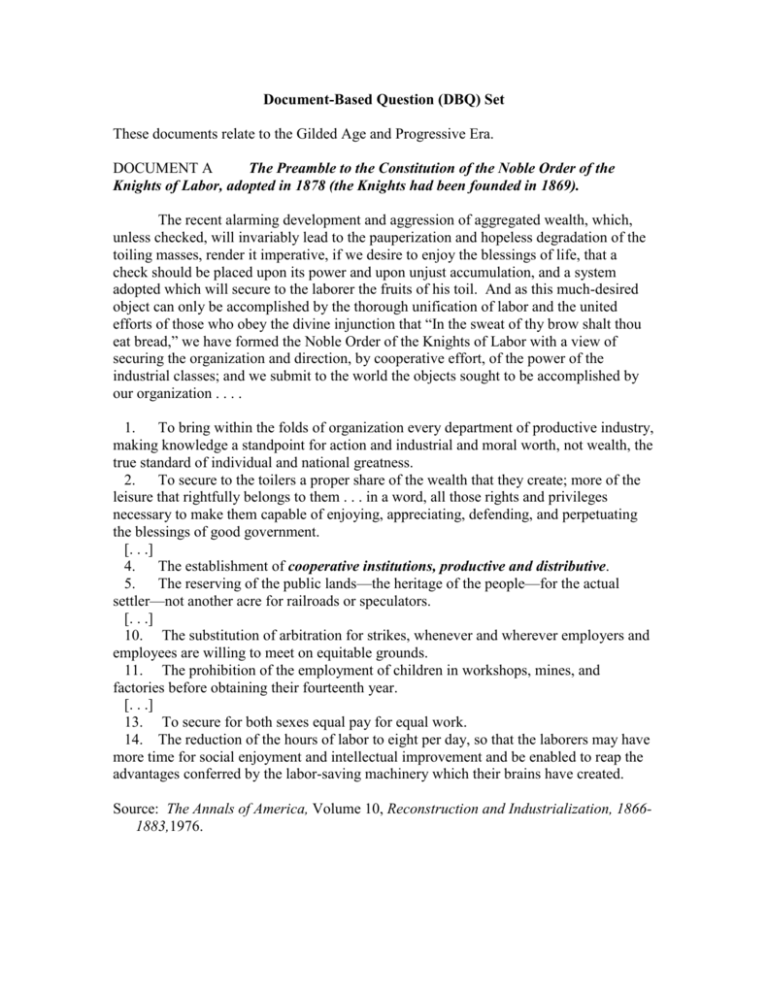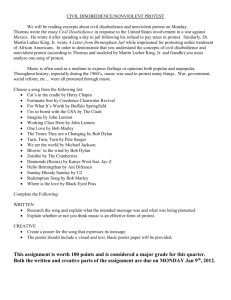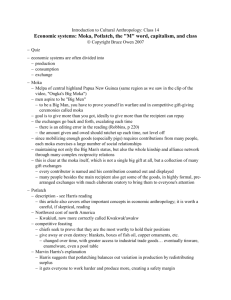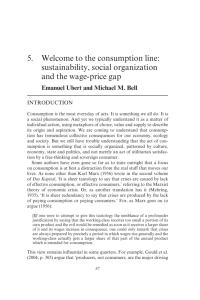Voices of Protest in the Progressive Era
advertisement

Document-Based Question (DBQ) Set These documents relate to the Gilded Age and Progressive Era. DOCUMENT A The Preamble to the Constitution of the Noble Order of the Knights of Labor, adopted in 1878 (the Knights had been founded in 1869). The recent alarming development and aggression of aggregated wealth, which, unless checked, will invariably lead to the pauperization and hopeless degradation of the toiling masses, render it imperative, if we desire to enjoy the blessings of life, that a check should be placed upon its power and upon unjust accumulation, and a system adopted which will secure to the laborer the fruits of his toil. And as this much-desired object can only be accomplished by the thorough unification of labor and the united efforts of those who obey the divine injunction that “In the sweat of thy brow shalt thou eat bread,” we have formed the Noble Order of the Knights of Labor with a view of securing the organization and direction, by cooperative effort, of the power of the industrial classes; and we submit to the world the objects sought to be accomplished by our organization . . . . 1. To bring within the folds of organization every department of productive industry, making knowledge a standpoint for action and industrial and moral worth, not wealth, the true standard of individual and national greatness. 2. To secure to the toilers a proper share of the wealth that they create; more of the leisure that rightfully belongs to them . . . in a word, all those rights and privileges necessary to make them capable of enjoying, appreciating, defending, and perpetuating the blessings of good government. [. . .] 4. The establishment of cooperative institutions, productive and distributive. 5. The reserving of the public lands—the heritage of the people—for the actual settler—not another acre for railroads or speculators. [. . .] 10. The substitution of arbitration for strikes, whenever and wherever employers and employees are willing to meet on equitable grounds. 11. The prohibition of the employment of children in workshops, mines, and factories before obtaining their fourteenth year. [. . .] 13. To secure for both sexes equal pay for equal work. 14. The reduction of the hours of labor to eight per day, so that the laborers may have more time for social enjoyment and intellectual improvement and be enabled to reap the advantages conferred by the labor-saving machinery which their brains have created. Source: The Annals of America, Volume 10, Reconstruction and Industrialization, 18661883,1976. DOCUMENT B 1892 platform. The People’s Party of America assesses current America in its The conditions which surround us best justify our co-operation; we meet in the midst of a nation brought to the verge of moral, political, and material ruin. Corruption dominates the ballot-box, the Legislatures, the Congress, and touches even the ermine of the bench. The people are demoralized; most of the States have been compelled to isolate the voters at the polling places to prevent universal intimidation and bribery. The newspapers are largely subsidized or muzzled, public opinion silenced, business prostrated, homes covered with mortgages, labor impoverished, and the land concentrating in the hands of capitalists. The urban workmen are denied the right to organize for self-protection; imported pauperized labor beats down their wages, a hireling standing army, unrecognized by our laws, is established to shoot them down, and they are rapidly degenerating into European conditions. The fruits of the toil of millions are boldly stolen to build up colossal fortunes for a few, unprecedented in the history of mankind; and the possessors of these, in turn despise the Republic and endanger liberty. From the same prolific womb of governmental injustice we breed the two great classes— tramps and millionaires. [. . .] We have witnessed for more than a quarter of a century the struggles of the two great political parties for power and plunder, while grievous wrongs have been inflicted upon the suffering people. We charge that the controlling influence dominating both these parties have permitted the existing dreadful conditions to develop without serious effort to prevent or restrain them. Neither do they now promise us any substantial reform. They have agreed together to ignore, in the coming campaign, every issue but one. They propose to drown the outcries of a plundered people with the uproar of a sham battle over the tariff, so that capitalists, corporations, national banks, rings, trusts, watered stock, the demonetization of silver and the oppressions of the usurers may all be lost sight of. They propose to sacrifice our homes, lives, and children on the altar of mammon; to destroy the multitude in order to secure corruption funds on the millionaires. Assembled on the anniversary of the birthday of the nation, and filled with the spirit of the grand general and chief who established our independence, we seek to restore the government of the Republic to the hands of “the plain people,” with which class it originated. We assert our purposes to be identical with the purposes of the National Constitution, to form a more perfect union and establish justice, insure domestic tranquility, provide for the common defense, promote the general welfare, and secure the blessings of liberty for ourselves and our posterity . . . . Source: National Party Platforms, 1840-1972, 1973. DOCUMENT D From the Manifesto of the Industrial Workers of the World, adopted in Chicago, 1905. Social relations and groupings only reflect mechanical and industrial conditions. The great facts of present industry are the displacement of human skill by machines and the increase of capitalist power through concentration in the possession of the tools with which wealth is produced and distributed. Because of these facts, trade divisions among laborers and competition among capitalists are alike disappearing. Class divisions grow ever more fixed and class antagonisms more sharp. Trade lines have been swallowed up in a common servitude of all workers to the machines which they tend. New machines, ever replacing less productive ones, wipe out whole trades and plunge new bodies of workers into the ever growing army of tradeless, hopeless unemployed. As human beings and human skill are displaced by mechanical progress, the capitalists need use the workers only during that brief period when muscles and nerves respond most intensely. The moment the laborer no longer yields the maximum of profits, he is thrown upon the scrap pile, to starve alongside the discarded machine. A dead line has been drawn, and an age limit established, to cross which, in this world of monopolized opportunities, means condemnation to industrial death. The worker, wholly separated from the land and the tools, with his skill of craftsmanship rendered useless, is sunk in the uniform mass of wage slaves . . . . [. . .] Craft divisions foster political ignorance among the workers, thus dividing their class at the ballot box as well as in the shop, mine, and factory. Craft unions may be and have been used to assist employers in the establishment of monopolies and the raising of prices. One set of workers are thus used to make harder the conditions of life of another body of laborers. Craft divisions hinder the growth of class consciousness of the workers, foster the idea of harmony of interests between employing exploiter and employed slave. They permit the association of the misleaders of the workers with the capitalists in the civic federations, where plans are made for the perpetuation of capitalism and the permanent enslavement of the workers through the wage system. [. . .] Universal economic evils afflicting the working class can be eradicated only by a universal working-class movement. Such a movement of the working class is impossible while separate craft and wage agreements are made favoring the employer against other crafts in the same industry . . . . A movement to fulfill these conditions must consist of one great industrial union embracing all industries, providing for craft autonomy locally, industrial autonomy internationally, and working-class unity generally. It must be founded on the class struggle, and its general administration must be conducted in harmony with the recognition of the irrepressible conflicts between the capitalist class and the working class. It should be established as the economic organization of the working class, without affiliations with any political party . . . . Source: The Annals of America, Volume 13, Progressive Era, 1905-1913, 1976. DOCUMENT E From the Declaration of Principles of the Niagara Movement, adopted at Buffalo, New York, 1905. The members of the Conference . . . congratulate the Negro Americans on certain undoubted evidences of progress in the last decade, particularly the increase of intelligence, the buying of property, the checking of crime, the uplift in homelife, the advance in literature and art, and the demonstration of constructive and executive ability in the conduct of great religious, economic, and educational institutions. At the same time, we believe that this class of American citizens should protest emphatically and continually against the curtailment of their political rights. We believe in manhood suffrage; we believe that no man is so good, intelligent, or wealthy as to be entrusted wholly with the welfare of his neighbor. We believe also in protest against the curtailment of our civil rights. All American citizens have the right to equal treatment in places of public entertainment according to their behavior and deserts. We especially complain against the denial of equal opportunities to us in economic life; in the rural districts of the South this amounts to peonage and virtual slavery; all over the South it tends to crush labor and small business enterprises; and everywhere American prejudice, helped often by iniquitous laws, is making it more difficult for Negro Americans to earn a decent living. [. . .] Any discrimination based simply on race or color is barbarous, we care not how hallowed it be by custom, expediency, or prejudice . . . . We protest against the “Jim Crow” car, since its effect is and must be to make us pay first-class fare for third-class accommodations, render us open to insults and discomfort, and to crucify wantonly our manhood, womanhood, and self-respect . [. . .] Persistent, manly agitation is the way to liberty, and toward this goal the Niagara Movement has started and asks the cooperation of all men of all races. Source: Ibid. DOCUMENT H Doris Stevens describes the women’s suffragists who were arrested for protesting outside the White House in 1917. Finding that a Suffrage Committee in the House and a report in the Senate had not silenced our banners, the [Wilson] administration cast about for another plan by which to stop the picketing. This time they turned desperately to longer terms of imprisonment. They were, indeed, hard pressed when they could choose such a cruel and stupid course. Our answer to this policy was more women on the picket line on the outside, and a protest on the inside of the prison. We decided, in the face of extended imprisonment, to demand to be treated as political prisoners. We felt that, as a matter of principle, this was the dignified and selfrespecting thing to do, since we had offended politically, not criminally. We believed further that a determined, organized effort to make clear to a wider public the political nature of the offense would intensify the administration’s embarrassment and so accelerate their final surrender. It fell to Lucy Burns, vice-chairman of the organization, to be the leader of the new protest. Miss Burns is in appearance the very symbol of woman in revolt. Her abundant and glorious red hair burns and is not consumed—a flaming torch. Her body is strong and vital . . . . She had no sooner begun to organize her comrades for protests than the officials sensed a “plot” and removed her at once to solitary confinement. But they were too late. Taking the leader only hastened the rebellion. A forlorn piece of paper was discovered on which was written their initial demand. It was then passed from prisoner to prisoner through the holes in the wall surrounding leaden pipes, until a finished document had been perfected and signed by all the prisoners. . . . Source: Stevens, Jailed for Freedom, New York, 1920, excerpted in The Annals of America, Volume 14, World War and Prosperity, 1916-1928, 1976. Questions 1) What is Document B discussing? What are they arguing about? What change do they want to see? (Typed reflection paragraph) (5 points) 1. Compare the assessments of the Knights of Labor (Document A) and the Industrial Workers of the World (Document D) as the problems of labor and the proper solutions to them. (Typed Reflection Paragraph) (5 points) 2. Using the documents and your own knowledge, explain the sources of political and social protest in the United States in the 1878-1916 period Documents E and H. (Typed Reflection 5 points)



![The Politics of Protest [week 3]](http://s2.studylib.net/store/data/005229111_1-9491ac8e8d24cc184a2c9020ba192c97-300x300.png)






